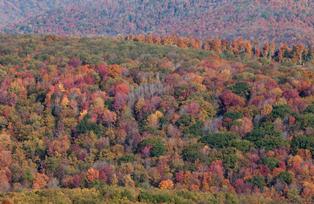FOREST VALUES
|
| [TUSAF ] - [ Residual Stand Protection ] - [ Forest Regeneration ] - [ Getting Help From Professionals ] - [ Aesthetics ] |
| [ Controlling Insects, Disease, Invasives, and Fire ] - [ Biomass Utilization ] - [ Soil and Water Resource Quality ] |
| |
|
Aesthetics
(The study of the mind and emotions related to the sense of beauty.)
|
|
Actively managing forests to ensure their health and value often requires activities such as road building and timber harvesting. Such activities can dramatically impact a forest’s visual appearance. A forest management plan gives a landowner the the capacity to see past the disturbed appearance of their harvested forest and allows them to focus on the goals that their forest operations bring them closer to. However, neighbors or other onlookers who do not share that same insight may interpret a harvest as shortsighted and destructive.
|

|
|
For some landowners, concerns over destroying the natural beauty and aesthetic values of their forest makes them reluctant to harvest timber. To the untrained eye it can be difficult to see the immediate and long-term benefits to wildlife, water, and recreational opportunities that foresters and professional timber harvesters know will evolve from proper forest management. There is no denying that a recently harvested area can be visually unappealing, but expectations can be managed by gaining an understanding of the temporary nature of the disturbance and the benefits that active management provides.
|
|
What might appear to be a tangle of limbs, branches, and leaves that remains after a harvest actually helps renew the forest. As the dead wood decays, nutrients cycle back into the soil and promote new growth. When a harvest is well planned and carefully implemented the disturbed appearance doesn’t last long. Seedlings, shrubs, wildflowers, and other herbaceous species fill exposed soils rapidly. These new sources of food and cover in turn attract a variety of insects, birds and mammals. The leftover woody debris or slash, protects young growth from too much light, strong winds, and hungry deer and provides additional cover to wildlife. The harvested forest is soon transformed to a lush area active with new life. Landowners who are still skeptical, should try visiting a forest that has been well managed in the past.
|
|
Since a forest’s appearance is subject to public perception and opinion, forest landowners, loggers, and foresters need to be aware of forest aesthetics and apply visual resource management practices to enhance the scenic quality of forest management activities.
|
|
Additional Resources:
|
|
|
|
|
Viewing Portable Document Format (PDF) publications: To view the PDF documents on this page you will need to have Adobe Acrobat® Reader installed on your computer. The software is available as a free download from the Adobe website.
|
| Links verified: Jan. 2024 |
| Please alert the webmaster of any defective links |
|









